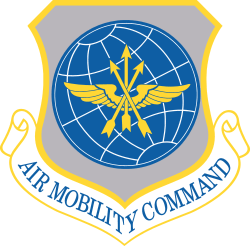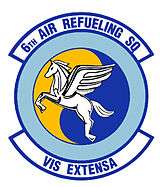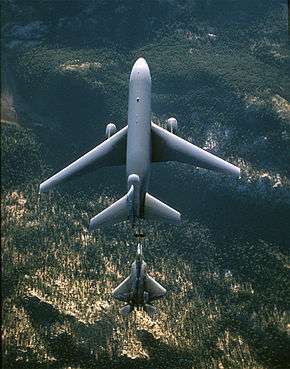6th Air Refueling Squadron
6th Air Refueling Squadron
 | |
|---|---|
|
A KC-10 Extender from Travis AFB refuels an F-22 Raptor | |
| Active | 1940-1946; 1947-1949; 1951-1951; 1957-1967; 1989 – present |
| Country |
|
| Branch |
|
| Role | Air Refueling |
| Part of |
Air Mobility Command 18th Air Force 60th Air Mobility Wing 60th Operations Group |
| Garrison/HQ | Travis Air Force Base |
| Motto(s) | Vis Extensa Latin Strength Extended |
| Engagements |
World War II Operation Restore Hope |
| Decorations |
Distinguished Unit Citation Air Force Outstanding Unit Award |
| Insignia | |
| 6th Air Refueling Squadron emblem |
 |
| 6th Bombardment Squadron emblem (approved 6 April 1942)[1] |
 |
| Aircraft flown | |
| Tanker | KC-10 Extender |
The 6th Air Refueling Squadron (6 ARS) is part of the 60th Air Mobility Wing at Travis Air Force Base, California. It operates the McDonnell Douglas KC-10 Extender aircraft conducting air refueling missions.
The squadron was first active during World War II as the 6th Bombardment Squadron. After the end of the war, the squadron served in the reserves from 1947 until 1949.
In 1951, the 6th Air Refueling Squadron was activated for a brief time. It was activated again in 1957 and served with Strategic Air Command for the next ten years.
The two squadrons were consolidated into a single unit in 1985. The consolidated squadron was activated again in 1989 as the 6th Air Refueling Squadron to operate the McDonnell Douglas KC-10 Extender.
History
World War II
The squadron was first activated as the 6th Bombardment Squadron in early 1940 as part of the pre-World War II buildup of the United States Army Air Corps after the breakout of war in Europe. It was assigned to the 29th Bombardment Group of the Northeast Air District and equipped with pre-production YB-17s. Later the squadron received early model B-17C and B-17D heavy bombers. After the Pearl Harbor Attack, the unit flew antisubmarine patrol missions in the Caribbean from January until June 1942.[1]
The squadron returned to the United States in June 1942 and was assigned to II Bomber Command. Was an Operational Training (OTU) and later a Replacement Training Unit (RTU) for B-17 heavy bomber units and replacement personnel until March 1944.[1]
The squadron was redesignated as a Boeing B-29 Superfortress very heavy bombardment squadron under Second Air Force. It deployed to the Pacific Theater of Operations and was stationed at North Field, Guam under XXI Bomber Command. It flew very long range strategic bombardment missions over the Japanese Home Islands, attacking military, industrial and transportation targets. The unit switched to night incendiary raids attacking major Japanese cities in the spring of 1945, causing massive destruction of urbanized areas. It continued strategic bombing raids and incendiary attacks until the surrender of Japan in August 1945.
The squadron remained in Western Pacific, although largely demobilized in the fall of 1945. Some aircraft were scrapped on Tinian; others flown to storage depots in the United States. Remained as a paper unit assigned to Twentieth Air Force until inactivated in early 1946.[2]
Reserve operations
The squadron was active from 1947 to 1949 as a reserve corollary squadron at Barksdale Air Force Base, Louisiana from 1947 to 1949.
Cold War
The 6th Air Refueling Squadron was activated briefly in 1951, but was inactivated a few months later, when its parent 6th Bombardment Group prepared to convert to Convair B-36 Peacemaker bombers, which lacked an air refueling capability. The squadron did not receive its complement of KB-29 tankers.
The squadron was again activated as the 6th Bombardment Wing prepared for the Boeing B-52 Stratofortress. It performed air refueling training from 1959 until 1962, when tanker training was concentrated at Castle Air Force Base, California. It flew worldwide air refueling missions from 1963 until 967, including support of tactical aircraft flying in Southeast Asia until the squadron was inactivated as Walker Air Force Base closed in 1967.
Modern era
On 19 September 1985 the 6th Air Refueling Squadron was consolidated with the 6th Bombardment Squadron.
The consolidated squadron was activated in 1989 as the 6th Air Refueling Squadron, a McDonnell Douglas KC-10 Extender unit. The squadron again flew worldwide air refueling, including support of deployments to Southwest Asia from, 1990 through 1991. It provided humanitarian airlift to Somalia from 1992 to 1993.[2]
Lineage
6th Bombardment Squadron
- Constituted as the 6th Bombardment Squadron (Heavy) on 22 December 1939
- Activated on 1 February 1940
- Redesignated 6th Bombardment Squadron, Very Heavy on 28 March 1944
- Inactivated on 1 April 1944
- Activated on 1 April 1944
- Inactivated on 20 May 1946
- Activated in the Reserve on 15 June 1947
- Inactivated on 27 June 1949
- Consolidated with the 6th Air Refueling Squadron as the 6th Air Refueling Squadron on 19 September 1985[2]
6th Air Refueling Squadron
- Constituted as the 6th Air Refueling Squadron, Medium on 6 April 1951
- Activated on 10 April 1951
- Inactivated on 1 August 1951
- Redesignated 6th Air Refueling Squadron, Heavy on 1 April 1957
- Activated on 1 November 1957
- Discontinued and inactivated on 25 January 1967
- Consolidated with the 6th Bombardment Squadron on 19 September 1985
- Activated on 3 January 1989
- Redesignated 6th Air Refueling Squadron on 1 September 1991[2]
Assignments
- 29th Bombardment Group, 1 February 1940 – 1 April 1944
- 29th Bombardment Group, 1 April - 20 May 1946
- Tenth Air Force, 15 June 1947
- 482d Bombardment Group, 30 September 1947 – 27 June 1949
- 6th Bombardment Group, 10 April 1951 – 1 August 1951
- Fifteenth Air Force, 1 November 1957
- 6th Bombardment Wing (later 6 Strategic Aerospace Wing), 3 January 1958 – 25 January 1967
- 22d Air Refueling Wing, 3 January 1989
- 22d Operations Group, 1 September 1991
- 722d Operations Group, 1 January 1994
- 60th Operations Group, 1 August 1995 – Present[2]
Station
- Langley Field, Virginia, 1 February 1940
- MacDill Field, Florida 21 May 1940
- Gowen Field, Idaho 25 June 1942 – 1 April 1944
- Pratt Army Air Field, Kansas 1 April – 7 December 1944
- North Field, Guam, Northern Mariana Islands, 17 January 1945 – 20 May 1946
- Barksdale Field (later Barksdale Air Force Base), Louisiana, 15 June 1947 – 27 June 1949
- Walker Air Force Base, New Mexico, 10 April 1951 – 1 August 1951
- Bergstrom Air Force Base, Texas, 1 November 1957
- Walker Air Force Base, New Mexico, 3 January 1958 – 25 January 1967
- March Air Force Base, California, 3 January 1989
- Travis Air Force Base, California, 1 August 1995 – Present[2]
Aircraft Operated
- YB-17 (1940)
- B-17 Flying Fortress (1940–1943, 1944)
- B-18 Bolo (1940–1941)
- B-24 Liberator (1943–1944)
- B-29 Superfortress (1944–1946)
- AT-6 Texan (1947–1949)
- AT-11 Kansan (1947–1949)
- Boeing KB-29 Superfortress (1951)
- KC-135 Stratotanker (1958–1967)
- McDonnell Douglas KC-10 Extender (1989 – present)[2]
Operations
See also
References
Notes
Bibliography
![]() This article incorporates public domain material from the Air Force Historical Research Agency website http://www.afhra.af.mil/.
This article incorporates public domain material from the Air Force Historical Research Agency website http://www.afhra.af.mil/.
- Maurer, Maurer, ed. (1982) [1969]. Combat Squadrons of the Air Force, World War II (PDF) (reprint ed.). Washington, DC: Office of Air Force History. ISBN 0-405-12194-6. LCCN 70605402. OCLC 72556.


